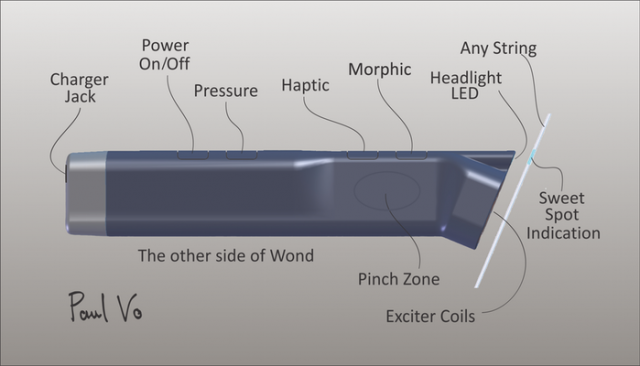
Designer Paul Vo’s Kickstarter project to fund the production of his new Wond String Exciter has reached its funding goal, with more than two weeks left to go.
The Wond String Exciter is a new device, designed to let you explore new ways of playing string instruments.
Vo’s instruments explore the idea of ‘acoustic synthesis’ – using electronics to control the vibration of physical objects and to shape the harmonics of the resulting sounds.
According to Vo, the Wond is the most powerful handheld exciter, sustainer and controller ever invented. It is a magnetic plectrum for strings, that lets you create infinite sustain and play the harmonics of a string in new ways.
While the Wond is targeted towards guitarists, Vo notes that “it will drive just about any instrument with steel strings. Pianos, harps, violins – you name it!”
Here’s the official video intro:
Here’s an overview of the Vo Wond prototype from this year’s NAMM Show:
Features:
- Exciter Coils – These are the coils used to excite the string of your instrument. They are controlled by how firmly you pinch the Wond. You can also use the different switches on the Wond to control their behavior.
- LED “Headlight” Guide/Slide – Dual purposed to offer a slide much like a traditional guitar slide. The durable notched tip allows you to slide notes on the string while manipulating them with the Wond. In addition, the Wond’s “Headlight” LED helps you align Wond to the string visually – when the LED light falls on the string you are close to the sweet spot!
- Multi-colored LED – Illuminates when the Wond is activated by the Pinch Control. The LED is also used as a battery charge indicator. It will glow less and less blue and more red as the battery depletes, giving you a visual warning of when to charge the Wond.
- Pinch Zone – This is the area of the Wond that you pinch to excite the string. Pinching this spot governs the Wond’s behavior. With Pressure mode set to Off, pinching will simply apply power to the string. With the Pressure switch On, the pressure you apply to the Wond is translated into a control signal to governing the Wond’s power and harmonic response.
- Morphic Switch – Selects between two different Wond behaviors that produce different sets of timbres.
- Haptic Switch – In the On position, this will provide tactile feedback to the player through the Wond so the string can be “felt” as the Wond approaches the “sweet spot”. This feedback changes according to how close the Wond is to the string and also according to the amplitude of string vibration. There is enough information in this tactile feedback to play by feel, even with your eyes closed.
- Power Switch – Turns all power off to the Wond when you are not using it.
- Charging Connection – Located at the rear of the Wond, this allows you to re-charge the Wond when the battery is low or depleted.
The Vo Wond is available to project backers starting at US $198. It is expected to start shipping in September 2015.

A preemptive reply to the haters that will inevitably show up:
I promise you that while it has similarities to the EBow, it has differences as well. I’ve played 2 out of 3 of Paul’s inventions (the VO-96 and now the Wond), and it is a different experience.
The inventor of the EBow (whose name eludes me) welcomes the progress being made here and is happy for Paul in his venture.
While the Wond may work similarly to an EBow (which I own), it does not play the same. It has more power and more precision, plus more features (like harmonic selection options, and the ability to work on violin and bass guitar). And this is from just playing the prototype.
I’m not endorsed by Paul Vo in any way. I’m just enthusiastic about having this new tool for my musical toolbox. I will not be selling my EBow; the Wond is a welcome addition.
Sidebar: I can’t stand all the negativity by random people about this product. My best polite retort is: Why bother to make more than one shape, style, type of guitar? They’re all the same, right? Surely all guitars do the same thing. Yet no one complains when Fender or Gibson release new models each year about “been there, seen that.” Same applies for synths.
Embrace change and invention, friends. This conversation will *always* be present, and not everyone is educated or curious, so I’m trying to be patient whilst in the know.